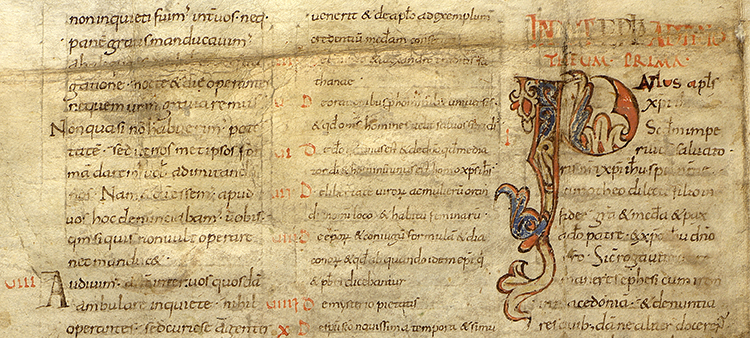| home | projects | project team | events | gallery | cooperations | publications | resources | media | contact | |
Matthias M. TischlerBible Manuscripts as Modes of Perception and Transformation of the World of the OthersThe Bible is the only book ever to be granted ‘World Heritage&rsqou; status by the UNESCO. Its cultural impact on the European Middle Ages has been massive, and has been studied from many perspectives by theologians, historians, literary scholars and others. Still, much remains to do, especially in fields where biblical influences may not be as immediately obvious as elsewhere. This regards, for instance, the role of biblical models for the formation of identity and difference, for perceptions of ethnicity and ‘otherness&rsqou;. How was Christianity as a ‘universal&rsqou; religion related to particular communities and identities, and to other religions? The present project seeks to follow this line of research in important respects and from a specific perspective by studying the transcultural setting of the Iberian Peninsula in the eighth to twelfth centuries. Historical approaches to the ‘Book of books&rsqou; from a transcultural perspective have so far been rather neglected. What was the relationship of the Bible to other holy or sacred scriptures, for instance the Muslim Qur&rsqou;ān and the Jewish Tanach and Talmud? How did it influence perceptions of other religious cultures, and their interaction with Christians, in terms of liturgy, historiography, and polemics? A modern history of the Bible in Iberian World up to the Central Middle Ages is still missing. This is more than a lamentable situation of research, as the fundamental codicological and philological research on the most important Iberian Bible manuscripts, conducted especially by Samuel Berger, Donatien de Bruyne, Bonifatius Fischer, Teófilo Ayuso Marazuela, Ana Suarez González and Paolo Cherubini had begun to expose the landscape of production and reception of a renewed biblical legacy without assessing the new transreligious and transcultural setting of these activities: We know much (but not really in detail) the production of the great Visigothic and Carolingian Bibles (preserved pandects, fragments and witnessed, but now lost manuscripts) and where it took place, as well as the role played by the Visigothic and Carolingian Bible editions by Peregrinus, Isidore of Sevilla, Theodulph of Orléans and Alcuin of Tours within the general history of the Vetus Latina and the Vulgata. And the afore-mentioned scholars also demonstrated the import of Western Frankish and Septimanian Bible texts into the Northern and North-Eastern parts of the Iberian Peninsula. This process continued until the new type of glossed French Bible manuscripts of the twelfth and early thirteenth centuries started to predominate with its characteristic multivolume sets both in the centres and on the peripheries of scholastic biblical studies alike. More detailed research has also singled out several outstanding Latin Bibles transported from Mozarabic Andalusian communities to the Christian Northern regions of the Peninsula. This phenomenon has furthermore helped us to characterize these and other top-quality specimina of Latin-Christian book production as cultural beacons in the resurgent societies of a territorial, religious, cultural and intellectual Reconquista. Samples like the Biblia Hispalensis of Córdoba, later given to Sevilla, have thus been interpreted as testimonies of Christian resistance against Muslim authority and as the central medium of Christian propaganda putting forward their specific perception of the World&rsqou;s place in space and time. Yet what we now lack is the reconstruction of the mental map of the Christian religious and intellectual resistance in the sphere of the whole Iberian panorama of biblical production and the rhythms of production and perception of Bible editions (in one or more volumes) and of single Bible books. Against the backdrop of the parallel historiographical production, this project will assess the individual positioning of whole book groups and single books within the Bible canon(s), their illumination and their frequent use (revealed by marginal notes, commentaries, stains of ink etc.), with the purpose of uncovering the anthropological, social, religious and theological interests of their contemporary and later sponsors, readers and owners. Were the books of the Pentateuch construed as the history and law of a New Hispanic Israel? Were the Major and Minor Prophets and the Revelations utilized as typological models for prophetic and visionary concepts of contemporary times, and what relationship between the books of Daniel and Apocalypsis can be deduced from their positioning and illumination in the Bibles? In which contexts of the Bibles do we find representations of the Holy Cross, of Christological and of Messianic topics, but also of the antagonists of God and his chosen people? And what is the practical purpose of the transmission of the so-called ‘apocryphs&rsqou;, biblical paratexts (prologues, arguments, capitulations etc.) and extra-biblical texts such as the astonishingly rich computistic, chronological, genealogical, prophetic and sybillinic text material that can also be found in many medieval Iberian Bibles? |
  → Christian communities and their media,M. Pollheimer → Semantics and narratives of ethnicity, C. Grifoni → Regional and ethnic identities in Roman and post-imperial Europe, K. Winckler → Regional and ethnic identities in Roman and post-imperial Europe, R. Steinacher → Identity, material objects and cultural transfer, F. Conselvan → Columbanus and the Politics of Exile, A. O'Hara → Die Fredegar-Chronik, A. Fischer → The Bible as a Repository of Identities in Early Medieval Historiography, P. Dörler → Imperial Carolingian identity in ninth-century Italy, C. Gantner → Bible Manuscripts as Modes of Perception, M. Tischler → State, Taxation and Power in in Late Roman West A.D. 300-700, P. Tedesco → Problem of the Ethnic Identity in Bohemia during the rule of Premyslid, D. Kalhous → Hunting and elite cohesion, H. Barak → Chroniclers, Crusaders, and the Last Pagans of Europe, S. Donecker
|
